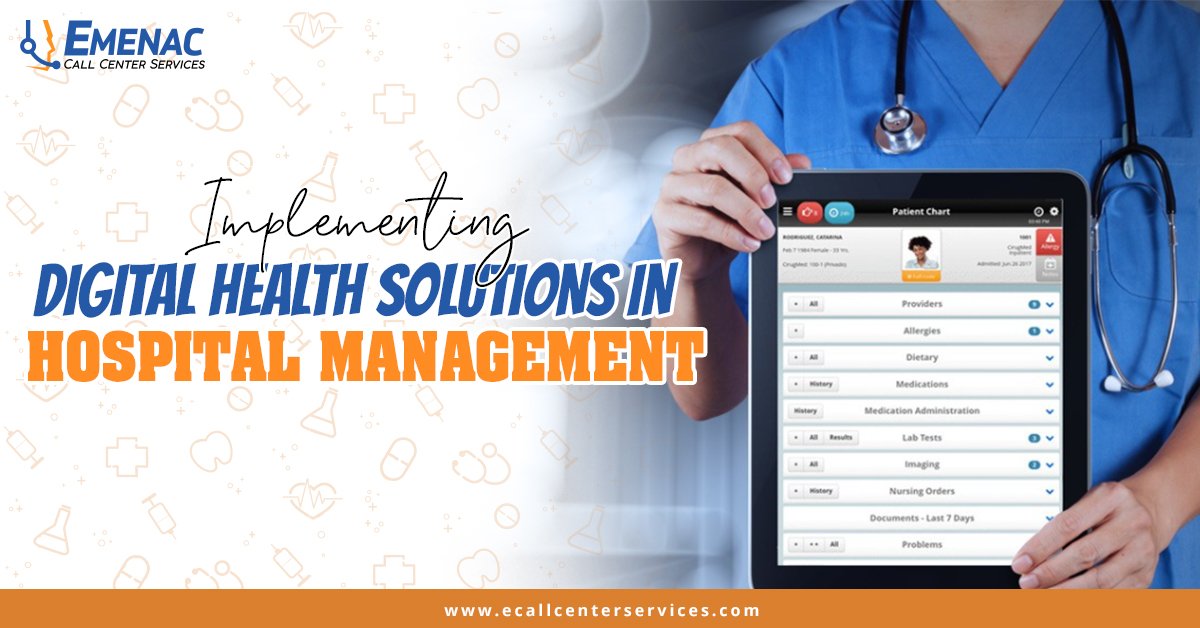Healthcare is undergoing upgrades with every passing day via the implementation of digital health solutions in hospital management. This new revolution is about how hospitals operate, improve patient care, and optimise their resources. Rather than using the conventional methods of managing healthcare systems, which rely on paper records, manual processes, and face-to-face consultations, are rapidly being replaced by digital inventions that facilitate processes and offer better patient outcomes.
This article explores the importance of digital health solutions in hospital operations, conversing about the different tools and technologies and the key benefits and challenges of integrating these systems.
Significance of Digital Health Solutions in Modern Hospital Management
The use of technology to monitor, and improve healthcare practices is referred to as digital health solution. There is a wide range of equipment including electronic health records, telemedicine, artificial intelligence, data analytics, and mobile health applications. These innovative tools are revolutionizing every aspect of hospital operations, from administrative efficiency to clinical results.
Following are some Fundamental areas where digital health impacts hospital management include:
- Data Management: Digital systems enable the seamless storage, retrieval, and sharing of patient records.
- Improved Care: Remote monitoring and AI-powered diagnostics enhance the ability to provide timely and accurate care.
- Functional Efficiency: Automation and digital tools streamline workflow, resource allocation, and staff management.
- Expense Management: Reducing paperwork, improving resource utilization, and minimizing human errors contribute to significant cost savings.
By implementing the new technology, hospitals can reduce inefficiencies, save time, and provide more personalized care. For instance, appointing a virtual appointment setter can eliminate manual errors in scheduling and ensure patients are consistently informed about their appointments.
Key Digital Health Solutions for Hospital Management
1. Electronic Health Records (EHR)
Among the digital health solutions, one of the most major upgrades is the Electronic Health Records which has proved to be the backbone of hospital management, leaving behind the traditional paper records with a modern digital system that ensures data accuracy and accessibility. This upgrade allows healthcare providers to track patient data over time, easily share information with other medical professionals, and offer better-coordinated care.
Advantages of EHR:
- Real-time management of patient records.
- Reduction in the chance of medical errors due to inaccurate or missing information.
- Improved care coordination among specialists.
- Enhanced patient privacy and security.
By compiling patient information in a database, hospitals can not only reduce paperwork but also ensure that all healthcare providers involved in a patient’s treatment are on the same page with the past medical history, reducing monotony and enhancing the efficiency of provided care.
2. Telemedicine and Remote Monitoring
After COVID-19, telehealth or telemedicine has emerged significant source to bridge the gap in healthcare, this is a type of digital health solution that provides initial medical advice via online resources and doctor consultations. Various channels are providing this facility online. These channels also integrate with other hospital management systems to streamline appointments, billing, and record-keeping.
Remote monitoring: This allows for continuous tracking of patients’ vital signs using wearable devices, which dispatch real-time data to healthcare professionals. This is extremely useful for managing chronic conditions like diabetes or heart disease, where constant monitoring is crucial.
Benefits:
- Support for the patients in rural or remote areas.
- Allow patients to connect with GP conveniently
- Constant monitoring helps in the early detection of complications.
- This digital health solution can help in cost reduction, making it a win-win for both patients and healthcare providers.
3. Artificial Intelligence (AI) in Diagnostics and Treatment
One of the most beneficial uses of AI is diagnosis and treatment as this new technology, even though still in beta version in various regions is revolutionizing the healthcare industry, with applications ranging from diagnostic imaging to personalized treatment plans. For instance, AI can assist in identifying tumours in radiology imaging or forecasting patient outcomes based on historical data.
AI for the Hospital Management:
- Assisting the healthcare practitioners with efficient diagnostics.
- Treatment plans optimization by analyzing patient history and outcomes.
- Predicting what patient requires, for instance in case of potential complications or the need for ICU admissions, improving resource distribution.
By incorporating AI into hospital workflows, healthcare institutions can enhance both the speed and accuracy of their medical interventions, leading to better patient outcomes and more efficient hospital management.
4. Data Analytics and Predictive Modeling
There is a huge amount of data being produced in healthcare facilities on a daily basis. From patient records to billing information, data analytics enables hospitals to harness this data for informed decision-making. Predictive modelling can recognize trends, such as disease outbreaks or patient admission stats, helping hospitals prepare for optimizing resource allocation and surges in demand.
Applications of Data Analytics in Hospitals:
- Identifying the requirement of the preventive arrangements
- Optimization of the staff duty scheduling as per the surge of patients
- Financial planning and budgeting enhancement.
With the help of these advanced analytics, medical facilities and hospitals can also keep a record of the key performance indicators (KPIs) such as patient satisfaction, readmission rates, and average treatment times, enabling continuous improvement in service delivery.
5. Mobile Applications
Mobile applications are another emerging tool that enables patients to monitor their health from their smartphones or tablets. These apps can integrate with hospital systems, allowing patients to access their medical records, schedule appointments, and receive reminders for medication or follow-ups.
Benefits of Mobile Apps
- Enhancement in the patient engagement and adherence to treatment plans.
- Real-time access to health data for both patients and doctors.
- Reduction in the administrative burden for hospital staff through automated scheduling and reminders.
With mobile apps, hospitals also get better communication between healthcare practitioners and patients. Providing the access on both ends for the data and the communication. This app also has a dedicated virtual appointment setter for maintaining the humanization aspect.
Conclusion
There is immense potential in digital health solutions and Implementing these can transform healthcare delivery, enhance operational efficiency, and improve patient care. From EHRs and telemedicine to AI-driven diagnostics and mobile health applications, digital tools are revolutionizing how hospitals operate. While there are challenges in adoption, including cost, training, and data security, the long-term benefits far outweigh the obstacles.
Those hospitals that are determined to manage daily tasks more efficiently, leveraging resources like an appointment setter virtual assistant can help automate and optimize the scheduling process. This not only improves administrative efficiency but also ensures that patients receive timely care, contributing to overall satisfaction.
With the advance of healthcare facilities reliance on traditional, manual processes is shifting toward digital innovations that streamline operations, improve patient outcomes, and enhance overall efficiency.


